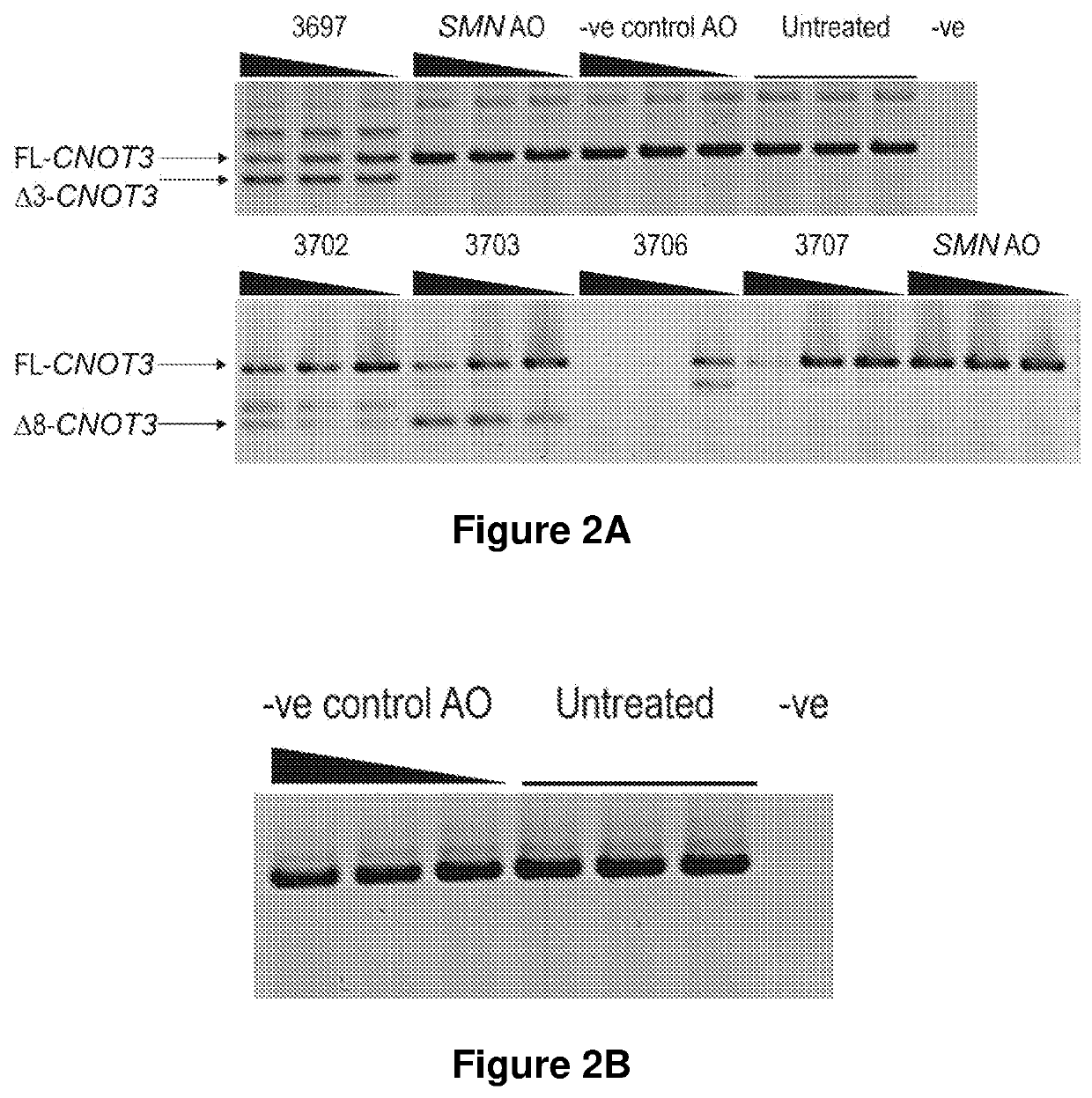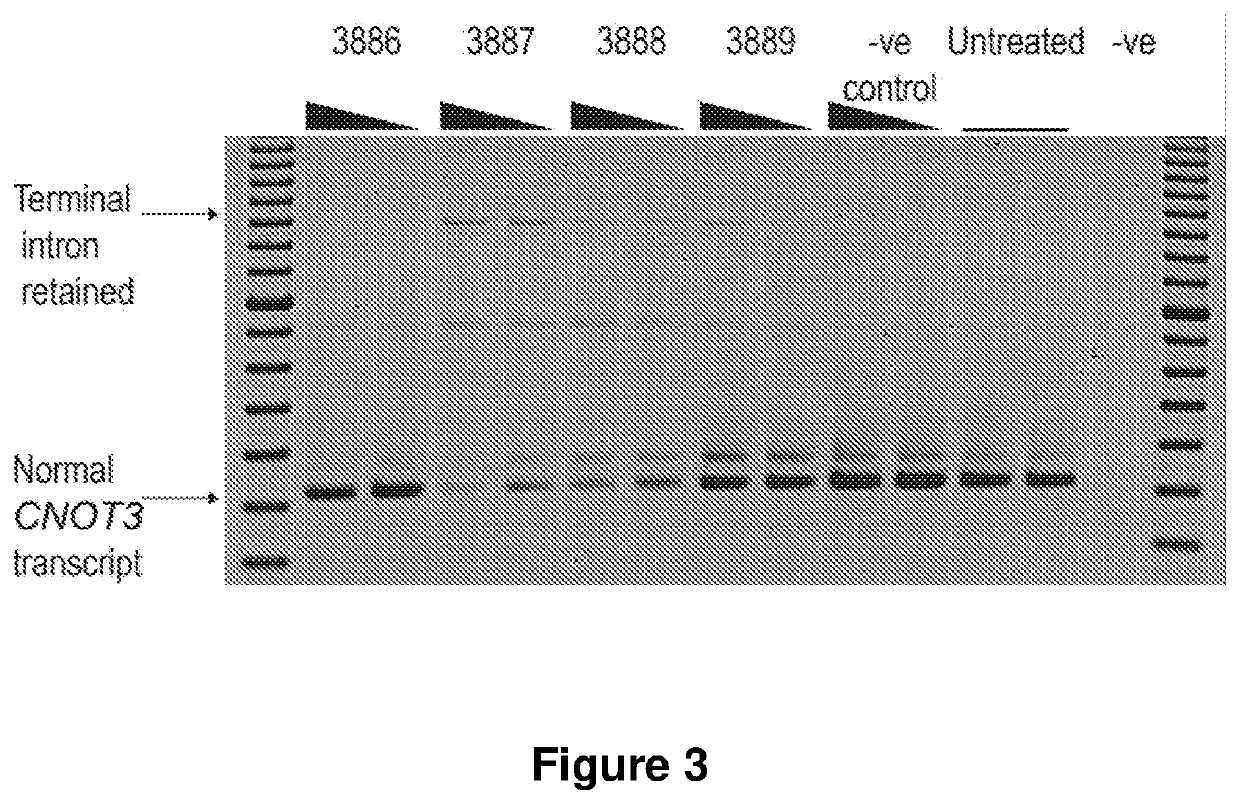Novel Retinitis Pigmentosa Treatment
a technology of retinitis pigmentosa and treatment method, which is applied in the field of new retinitis pigmentosa treatment method, can solve the problem that it is not known if ocular viral mediated gene therapy could be re-administered
- Summary
- Abstract
- Description
- Claims
- Application Information
AI Technical Summary
Benefits of technology
Problems solved by technology
Method used
Image
Examples
example 1
AO Mediated Exon Skipping to Induce a Frame-Shift in CNOT3
[0198]The exon structure of CNOT3 is shown in FIG. 1. Splice switching AOs were designed to target enhancer sites within frame-shifting exons in CNOT3 pre-mRNA (FIG. 1), to induce exon skipping and consequently, loss of the open reading frame and knockdown of CNOT3.
[0199]Normal human fibroblasts and fibroblasts from an RP11 patient (PRPF31 c.1205 C>A Ser402*) were obtained from skin biopsies and cultured in DMEM supplemented with 10% FBS. Antisense sequences (Table 1), synthesised in-house as 2′O-Methyl phosphorothioate oligomers were transfected into fibroblasts in 24 well plates as lipoplexes using Lipofectamine 3000 (Life Technologies), as per the manufacturer's instructions. Sequences that were effective in altering target exon selection were then synthesized as phosphorodiamidate morpholino oligomers (PMO) and transfected into fibroblasts as i) uncomplexed ii) annealed to a sense ODN leash and delivered with Lipofectamin...
example 2
AO Mediated Terminal Intron Retention to Knock Down CNOT3
[0209]Antisense sequences were designed to target the terminal exon of CNOT3 in order to induce terminal intron retention and knock-down of CNOT3.
[0210]2′O-Methyl AOs targeting the terminal exon of CNOT3 were transfected into adRP11 patient fibroblasts for 48 hr. RT-PCR analysis of the CNOT3 transcripts showed AOs 3887, 3888 and 3889 (Table 1) induced terminal intron retention and reduction in the level of full-length transcript product, in a dose dependent manner (FIG. 3).
example 3
[0211]Recruitment and Review of Families with RP
[0212]We have examined 3 generations of 2 families in WA (1 Caucasian and 1 Aboriginal) with PRPF31 mutations (FIG. 4). We have obtained dermal fibroblast from 7 patients and have started monitoring disease progression in 10 of 24 affected individuals in these families.
TABLE 3RP11-causing mutations identified and respective number of patients with eachconfirmed mutation (information from Australian Inherited retinal disease register as of 2018).MutationProtein changePhenotypeNumber affected (state)PRPF31.1205C > ASer402*Dominant RP9 (WA)PRPF31.267delAGlu89AspfsDominant RP8 (WA, Vic)PRPF31.527 + 3A > GN / A: SPLICEDominant RP3 (NSW)PRPF31.319C > GLeu107ValDominant RP1 (SA)PRPF31.527 + 1G > TN / A: SPLICEDominant RP1 (WA)PRPF31.1289_1290insAXDominant RP1 (SA)
PUM
| Property | Measurement | Unit |
|---|---|---|
| Tm | aaaaa | aaaaa |
| Tm | aaaaa | aaaaa |
| temperatures | aaaaa | aaaaa |
Abstract
Description
Claims
Application Information
 Login to View More
Login to View More - R&D
- Intellectual Property
- Life Sciences
- Materials
- Tech Scout
- Unparalleled Data Quality
- Higher Quality Content
- 60% Fewer Hallucinations
Browse by: Latest US Patents, China's latest patents, Technical Efficacy Thesaurus, Application Domain, Technology Topic, Popular Technical Reports.
© 2025 PatSnap. All rights reserved.Legal|Privacy policy|Modern Slavery Act Transparency Statement|Sitemap|About US| Contact US: help@patsnap.com



